 An illustrious institution like Kozhikode’s St Joseph’s Boys’ Higher Secondary School with a lot of history is rare. A precious gem in the educational arena, St Joseph’s has bred countless renowned educators. At the same time, the school has reared many well-known personalities in various fields. Politicians,bureaucrats,screen personalities, bankers and others in other professions have been products of St Joseph’s.
An illustrious institution like Kozhikode’s St Joseph’s Boys’ Higher Secondary School with a lot of history is rare. A precious gem in the educational arena, St Joseph’s has bred countless renowned educators. At the same time, the school has reared many well-known personalities in various fields. Politicians,bureaucrats,screen personalities, bankers and others in other professions have been products of St Joseph’s.
There are many former students in countless countries in distant continents. Reams of paper will be needed to name them all. Some people say that an alumnus of St Joseph’s might be found even in the distant moon. Doubtlessly, 227 years of the school’s existence has not been a waste.
St Joseph’s Boys’ School, on the eastern side of the Silk Street, was started in 1793. It was at first a parish school mainly meant for the Portuguese and local Christians. St Joseph’s is now the pride of Kozhikode, an ancient city of Kerala gifted with natural beauty with its long beach and coconut palm-fringed terrain. The number of students from Std 5 to 12 is almost 2400 now.
Kozhikode was the seat of the Zamorins. They were ruling the area when the Portuguese navigator Vasco da Gama landed at Kapad in 1498. The Zamorins welcomed the Portuguese with outstretched arms and soon struck business deals with them. The focus was on exporting spices. The settlement of the Portuguese Christians in Calicut thus began.
The Zamorins went further. They extended all possible help to the Portuguese and even allotted to them a plot of land on Silk Street. St Joseph’s grew up there. A church was then built nearby. Silk Street thus became the business hub of Calicut.
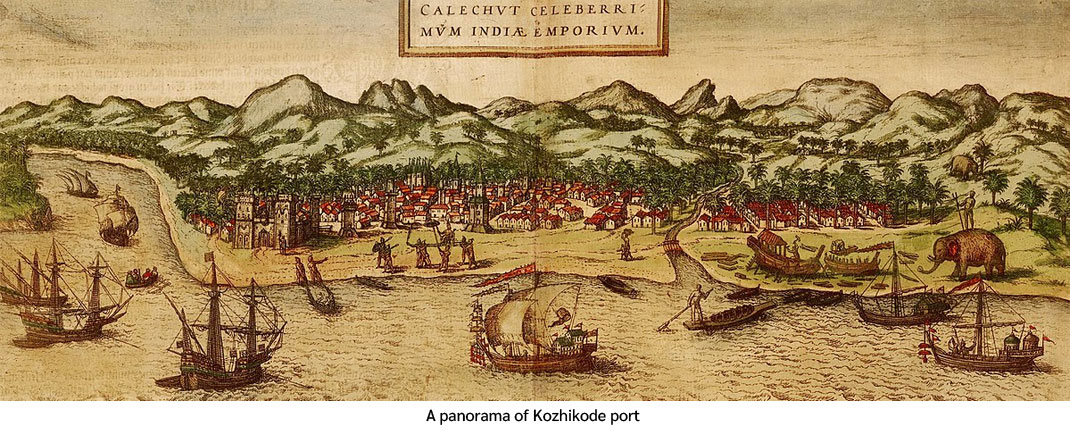
The founder of the school was Fr Gabriel Gonzalves, the priest in charge of the Matri Dei Church under the ecclesiastical jurisdiction of Kodungallor Vicariate. He started two schools; one for the Europeans and another for the Indians. The primary goal was to provide the children of Christian parents employed in various companies, with enough education, both physical and spiritual. Authentic documents that depict the history of the school from its inception in 1793 to 1860 are sadly not available.
In 1861 the Carmelite Fathers took up the administration of the church and the school. Under their strict supervision, the school became the best school in this area. They managed the school from 1861 to 1879.
On December 31, 1878, Jesuits for the province of Venice, landed in Mangalore. The entire South Canara district and the district of Malabar soon became the focus of their missionary activities.
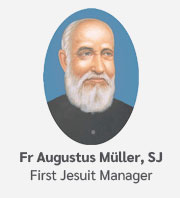
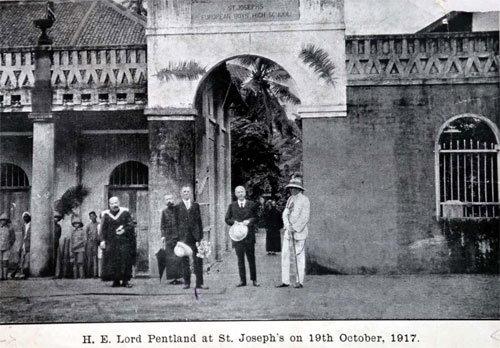 As soon as the Jesuits arrived to take up their new mission, the Carmelites left the parish and the Jesuits took over its administration. They also managed the school. Fr A. Muller SJ was the first Jesuit manager of the school. During this time the school was run by De la Salle Brothers and the standard of the school plummeted. Even the people began looking down on them. Perhaps because of the dwindling number of Brothers and the decline in their quality as teachers they withdrew from the school for good in 1884. The result: the school was taken over by the Jesuits.
As soon as the Jesuits arrived to take up their new mission, the Carmelites left the parish and the Jesuits took over its administration. They also managed the school. Fr A. Muller SJ was the first Jesuit manager of the school. During this time the school was run by De la Salle Brothers and the standard of the school plummeted. Even the people began looking down on them. Perhaps because of the dwindling number of Brothers and the decline in their quality as teachers they withdrew from the school for good in 1884. The result: the school was taken over by the Jesuits.
In 1888, pre-matriculation (Form IV -- present Std VIII) was started. In 1902, Fr C. Gonzalves SJ took over as the first Jesuit headmaster of the school. Till then, Mookorth Kumaran was the headmaster. On January 12 1904, Form V (Std 9) got recognition from the DPI. On 1904 August 10, Form VI was started and students appeared for public examinations. From 1906 to 1913, Fr Cavalier SJ functioned as the manager and headmaster of the school. The school then came under the Code of Regulation for European High Schools under the Madras Presidency. The school annual – The Josephite -- was brought out and in it a mention was made about the alumni association of the school. During this period the school’s prestige and fame increased considerably.
In 1914, as World War I raged in Europe, a two-storied building was completed to house the boarding. In 1917 the Captain’s Tank was given to the school by the municipality to be used as a playground. Small country boats access to this big tank from the sea. It took more than three years to fill this tank with mud and sand. By 1920, the ground was ready for use.

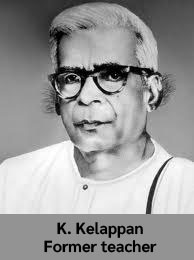 K. Kelappan, known as Kerala Gandhi, was a teacher in the school for a short period. He joined as the teacher of physics on February 16, 1918. He left after a short teaching stint. Kelappan later became the undisputed leader of the Sarvodaya Movement in Kerala.
K. Kelappan, known as Kerala Gandhi, was a teacher in the school for a short period. He joined as the teacher of physics on February 16, 1918. He left after a short teaching stint. Kelappan later became the undisputed leader of the Sarvodaya Movement in Kerala.
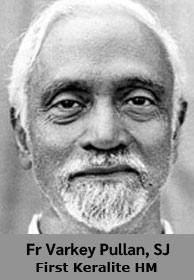 In June 1936, the new Indian school began functioning, combining both the European School and St. Antony's Middle School. In 1945 (during World War II) 10th Std attained 86% result. Malayalam medium classes were started from Std I to IV in 1946. In 1955 Fr Varkey Pullan, SJ the first Keralite Jesuit, became the headmaster. During the time of Fr Antony Manjil, SJ (1957-1961) both St. Antony’s UP School and St. Joseph's Middle School were separated. On July 3 1962, the ownership of the school and the entire property was handed over to the Kerala Jesuit Society by the Diocese of Calicut.
In June 1936, the new Indian school began functioning, combining both the European School and St. Antony's Middle School. In 1945 (during World War II) 10th Std attained 86% result. Malayalam medium classes were started from Std I to IV in 1946. In 1955 Fr Varkey Pullan, SJ the first Keralite Jesuit, became the headmaster. During the time of Fr Antony Manjil, SJ (1957-1961) both St. Antony’s UP School and St. Joseph's Middle School were separated. On July 3 1962, the ownership of the school and the entire property was handed over to the Kerala Jesuit Society by the Diocese of Calicut.
Fr Pedro Arrupe the then superior general of the Society of Jesus made his maiden visit to Kerala in January 1967. In the presence of a large gathering, he blessed the foundation stone of the four-storey building facing the school ground.
Fr JM Vergotini, SJ known as the football achan of Calicut was a teacher in the school in the forties. Under his able guidance and coaching, the school football team became one of the best in South India.
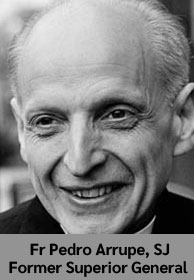
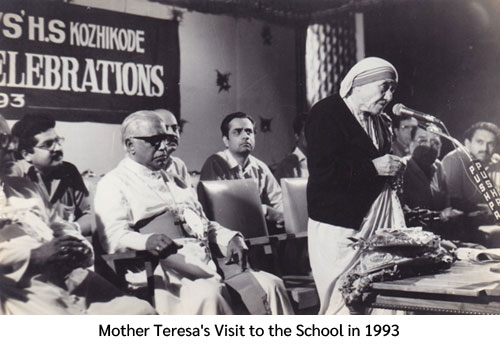 In 1969 Std 10th public exam's result touched a record 97.2%. Then came to era of Fr. Thomas Anthraper SJ. During his long 12 years of administration, he led the school to a higher level of excellence in various fields. Fr. Joseph Kallepallil, SJ took over the mantle from Fr Anthraper, planned and ably executed the school’s grand bicentenary celebration. Many developmental projects sprang up during his time including the bicentenary block with a grand auditorium.
In 1969 Std 10th public exam's result touched a record 97.2%. Then came to era of Fr. Thomas Anthraper SJ. During his long 12 years of administration, he led the school to a higher level of excellence in various fields. Fr. Joseph Kallepallil, SJ took over the mantle from Fr Anthraper, planned and ably executed the school’s grand bicentenary celebration. Many developmental projects sprang up during his time including the bicentenary block with a grand auditorium.
The most significant and blessed event that took place in the 200- year history of St Joseph’s was the visit of St Mother Theresa in connection with bi-centenary of the school. She reached the school on the evening of January 14, 1994, a Friday. She was accompanied by the Bishop of Kozhikode, Rt Rev. Dr Maxwell Norohna. When she entered the stage on the western side of the school ground there was thunderous ovation that reverberated through Kozhikode. The ground was full with a huge crowd of present students, old student, parents and the public. Her presence was considered a blessing for the city. Perhaps this is the most memorable event in the annals of the school.
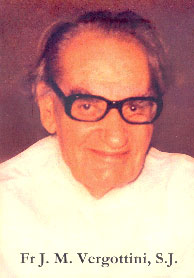
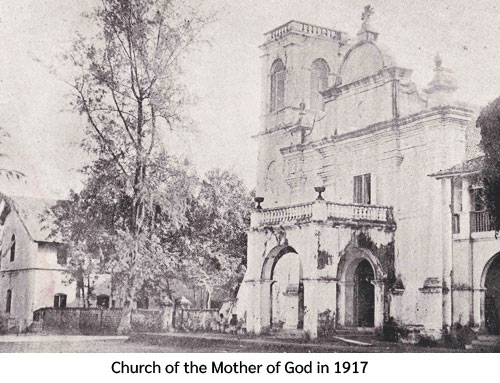 The school got the Higher Secondary section in 1998 with all three streams; Science, Humanities and Commerce batch. The Computer Science batch was added later.
The school got the Higher Secondary section in 1998 with all three streams; Science, Humanities and Commerce batch. The Computer Science batch was added later.
On October 15 2016, the foundation stone for the new Plus Two building was blessed and laid by Fr. M K George, the then Provincial. The work of the new building got over in July 2017 and it was blessed by Bishop Varghese Chackalackal, of Calicut.
The 225th Anniversary of the school was celebrated in 2017 with a year-long programme. The honour of being declared as the oldest school in Kerala was the highlight of the Jubilee Year. A press release by the government declared St Joseph’s as the oldest school in the state. “Edumine”, the national seminar on education brought together a large number of teachers from various schools, and papers were presented by eminent scholars. An evening programme titled Khalbile Kozhikode exposed the various faces of Calicut. A website titled www.sanjoboys.com featuring all available details of everyone associated with the school since Independence was created. The climax of the event was the global alumni meet Sanjo 225, a gathering of thousands of old students from different parts of the world. Apart from these programmes, the jubilee year witnessed many programmes like Fiesta 225, Literary Fests, Symphony – a gathering of present and former staff members and Arete 2K17, a state level quiz competition.
The year-long celebration of the 225th anniversary was concluded in the presence of MT Vasudevan Nair, noted Malayalam writer, and TP Ramakrishnan, the State Excise Minister. The installation 225, named Eternal Love, was opened to the public by Bishop Varghese Chakkalackal.
In short, the St Joseph’s still stands proudly holding its head ever higher in the centre of Kozhikode, attracting a vast number of students for admission in all classes. It has many more miles to go as it races ahead to make more conquests with the whole-hearted support and cooperation of staff, parents, the alumni association and well-wishers.
Written by Fr Sooraj Dominic SJ and Fr Joseph Edassery SJ